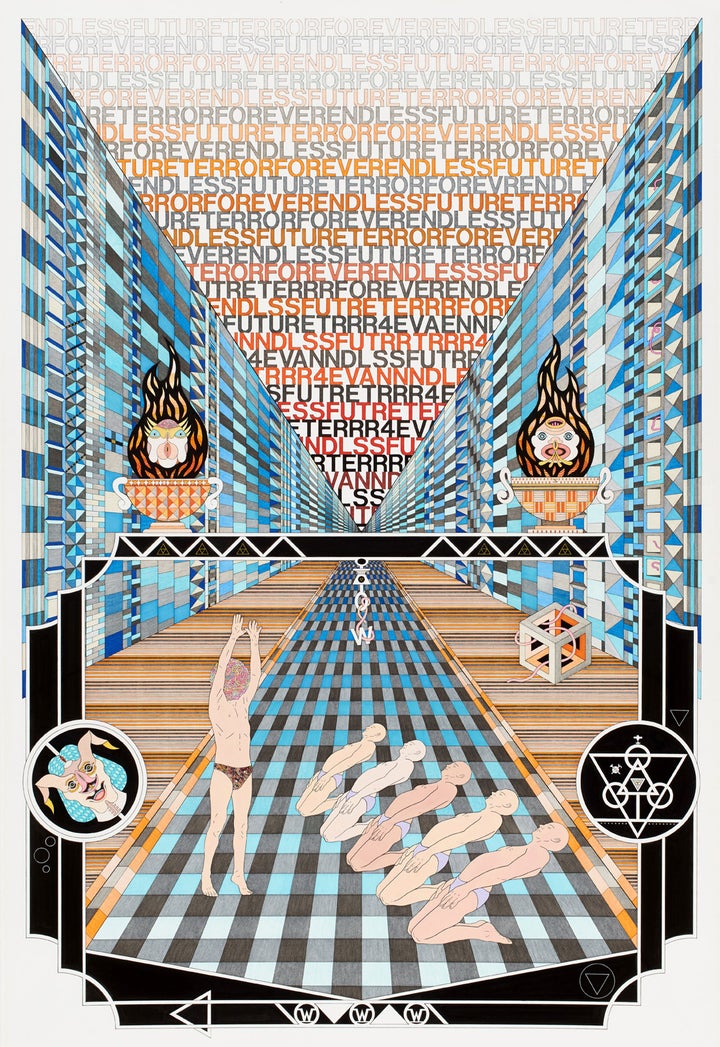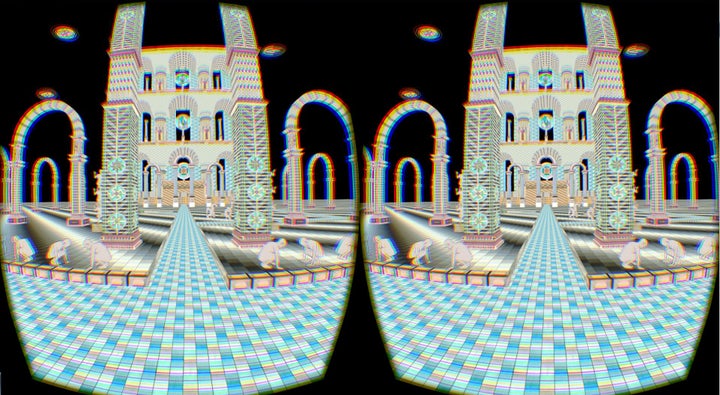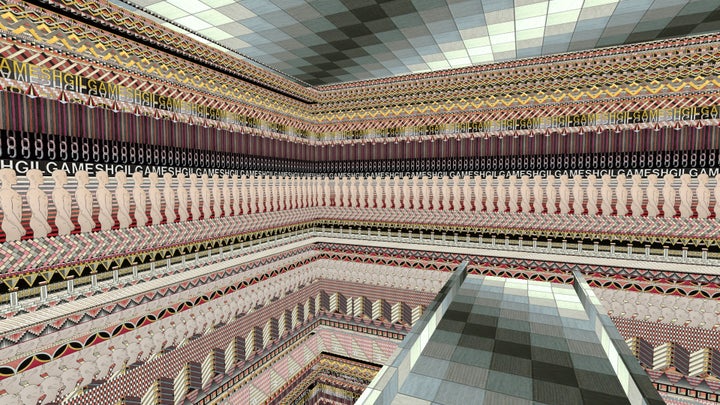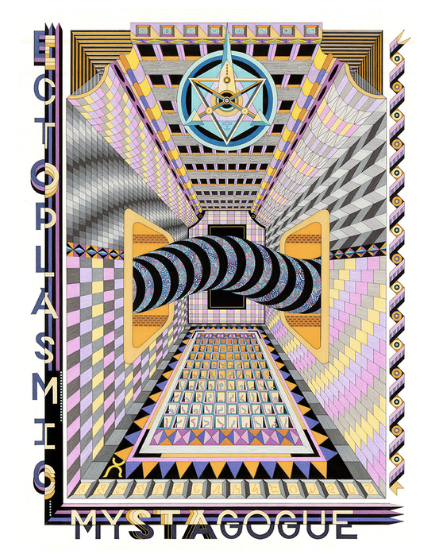
Pen, fibre tipped markers, collage and gouache on paper
151 x 105 cm
In virtual reality, it is an industry maxim that we design engaging, enjoyable experiences and promote user agency through intuitive, interactive interfaces. Such a human-centered perspective is well meaning, but it discounts the novel ways in which our proto-cyborg bodies might sense and interact with environments. How will altered perception change how we communicate and the forms of knowledge that we value? Although it is too early to foresee what the language(s) of VR will be, the work of Jess Johnson, a New Zealand born, New York based artist, whose work includes drawing, animation, video, installation and, recently, VR, offers some fascinating insights.

Jess Johnson and Simon Ward
Virtual Reality animation with audio, 5:35
Developer: Kenny Smith
Sound Design: Andrew Clarke
Taking inspiration from science fiction, Johnson’s art combines M.C. Escher-esque tessellations, masks, hyper-Cartesian architecture, anonymous prostrating figures, undulating worm-like creatures and short captions of text. For her VR piece, Ixian Gate, done in collaboration with Simon Ward, which premiered at The National Gallery of Victoria in Australia, Johnson began with drawing, not on the computer, but by hand. Johnson likens the constraints of her meticulous and labor-intensive practice to that of the Oulipo group of writers who created under specific rule-based or algorithmic conditions. Interestingly, when describing her process, she offers a spatial metaphor, one which hints at the potential for scale and physics to create new kinds of narrativity in VR. “I guess constraining myself to drawing this world by hand has an element of the ridiculous to it… but within these parameters the possibilities can seem infinite instead of restricted. Inside my studio, the world can seem very, very small but very, very large at the same time.”
Not only is the world of Ixian Gate horizonless, the experience begins with the user passively transported, as if on an invisible railcar, through the brightly colored, precisely drawn “sky” before being moved into a large architectural space. Watching the identical, hairless, sexless nude humanoid figures making strange, ritualistic prostrations, I felt a little like Catherine the Great being driven past a Potemkin Village in a foreign land. The overt passivity of the situation is not threatening. In some ways, this is a theatrical display, for whom, we are not sure, but none of the inhabitants seem at all affected by the user’s presence.

A giant worm-like creature glides by purposefully. Its undulations and non-linear movement suggest a kind of intelligence much more than the mutely performed rituals of the humanoid figures. Indeed, narrativity in Ixian Gate consists primarily of types of movement. However, the worm’s destruction of a wall does not add to a conventional notion of story. Rather, destruction here can be seen as just another surface effect. Perhaps, the most unsettling moment occurs when the user finds herself enclosed in a brick room in which the walls suddenly open to reveal a ticker tape like animation of text, humanoid heads and pattern. If the user moves her head quickly, her vision blurs with the parallax and she will realize that her body has been yoked to this machine-experience.
Szilak: There is a sense for the viewer of being both right there (in terms of bodily presence) but also invisible in terms of action and meaning. Do you think that movement through the space of VR is the key to narrative in that space? Do you see your works as narrative? Theatrical?
Johnson: There’s something akin to constructing a theatre set in the way I make the drawings. I’ll mentally build the architecture and then imagine the scene that might take place there. Once I’ve drawn the setting, I then populate it with inhabitants and play out a narrative. I’m basically creating little stage sets and plays for myself, where I can work out stuff through my cast of avatars. In terms of the ‘agency’ of the figures and the worms. The figures have none. I think of them as unformed as people. Nascent perhaps? They’re devoid of individual personalities and neutral in gender. I’m not sure about what the positions mean. I’ve spoken before about the figures being caught in repetitive gif cycles, unhinged from time and place. I don’t think the figures are actually of the world in the drawings. They’re like digital echoes. They’re manipulated into these positions of supplication to the demigod inhabitants of the world, but they’re unaware of their actions. The wurm brain represents the knowledge in the world. And the brain and the body are always kept apart. The thin stringy wurms that you see people ingesting or being wrapped around heads is knowledge (or data) in its physical form. Thought worms?
The experience of Ixian Gate is unsettling but pleasurable. For me, this combination of sensuality and control brings to mind the Italian Futurists’ celebration of the liberating aspects of technological as well as the slide toward fascism and the regimentation of social life that accompanied it. In 1924, anticipating the emergence of cyborg bodies, F.T. Marinetti published his Manifesto of Tactilism, offering this prescient insight: “The five senses, as they are commonly studied and defined, are more or less arbitrary localizations of that confused cluster of intertwined senses which constitutes the typical forces of the human machine.” In support of this, Marinetti created plans for “total theater.” As evidenced by the quote below, his vision resonates with the expectation that someday the rather awkward experience of VR will indeed evolve into the “total art” of the holodeck.
“Marinetti saw in the theatre one of the possible domains where tactilism could intervene to radically alter the cognitive and perceptive experience of the spectator. His theatrical production of the period was in fact not script based in its classical form, but it was a theatre of multi-sensorial and performative action. The rationality of the mind and of propositional knowledge of text-based theatre was replaced by physical performativity, by the bodily involvement of actors and spectators in both the production and fruition of the work of art.”
Interestingly, much of Johnson’s work includes bits of text. Like Marinetti, however, Johnson uses text primarily as a vehicle for paralinguistic and rhetorical devices. For instance, in the drawing “Ectoplasmic Mystagogue,” the meaning of the caption is ambiguous. The assonance of the words and the font itself are more readily understandable. Underneath a large worm-like creature, one sees rows of glyphs which appear as an alphabet of worm-like gestures. The conversion of language from letters to gestures is significant. It speaks to the fact that in VR, considerations of space, movement, and orientation within environments will be key. Moreover, it poses the question of how linguistic narrativity, which, with its focus on plot has been considered primarily an art of time, operates in spatially-oriented stories and art.

Pen, fibre tipped markers and gouache on paper
76 x 56 cm
Szilak: All of your work includes text. In fact, one of your drawings is titled, “A New Language Beckons Us.” What is that new language? How does text operate in the drawings? In VR?
Johnson: The language you speak has such a hold on how you can think and view the world around you. It’s restrictive and limiting in this way. If there are no words to describe an experience, its like you’re wading through mud—thoughts are half formed. If you want to build a new world, you need a new language to describe it. Language brings the world into focus. So naturally the language of my world is evolving at the same time as the imagery. Whenever I start a new drawing I first choose a piece of text from one of my notebooks. The text is almost always the starting point. Whatever amorphous vibe the words give off determines the imagery that comes. The phrases are often rhythmic and I choose them because they get stuck in my head like thought-worms. The text plays a really practical role in the construction of the drawings. The letters and words are like scaffolding and I often arrange the composition around them. The number of letters gives me mathematical starting points for mapping out other areas. VR doesn’t need the text element at all. No one notices the absence of the text in my animations or virtual reality. But it’s so important in the building (drawing) process. I need the language to bring the world into existence, but once it’s dragged into being, it’s solid enough to exist on its own.
In Understanding Media: Extensions of Man, Marshall McLuhan devotes several chapters to the role of spoken and written language in human communication. He concludes with a vision of the future, which to a more cynical mind, seems not unlike the world of Ixian Gate.
“Our new electric technology that extends our senses and nerves in a global embrace has large implications for the future of language…Electricity points the way to an extension of the process of consciousness itself, on a world scale, and without any verbalization whatever…The computer, in short, promises by technology a Pentecostal condition of universal understanding and unity.”
Marshall McLuhan
More recently, Chris Milk call VR “an empathy machine.” Whether these valorizing visions of technology will materialize, or if a darker, more normative version will prevail is unclear. What is certain is that, as it was a hundred years ago, artists like Jess Johnson are once again at the forefront, making work that speaks critically and imaginatively about our future.
Jess Johnson is represented by Darren Knight Gallery, Sydney, Australia and Ivan Anthony, New Zealand. Upcoming shows include August 2016: a solo exhibition at Talbot Rice Gallery, Edinburgh as part of the Arts Festival. and in early 2017, a major exhibition of new work in association with the K11 Foundation, Hong Kong.
